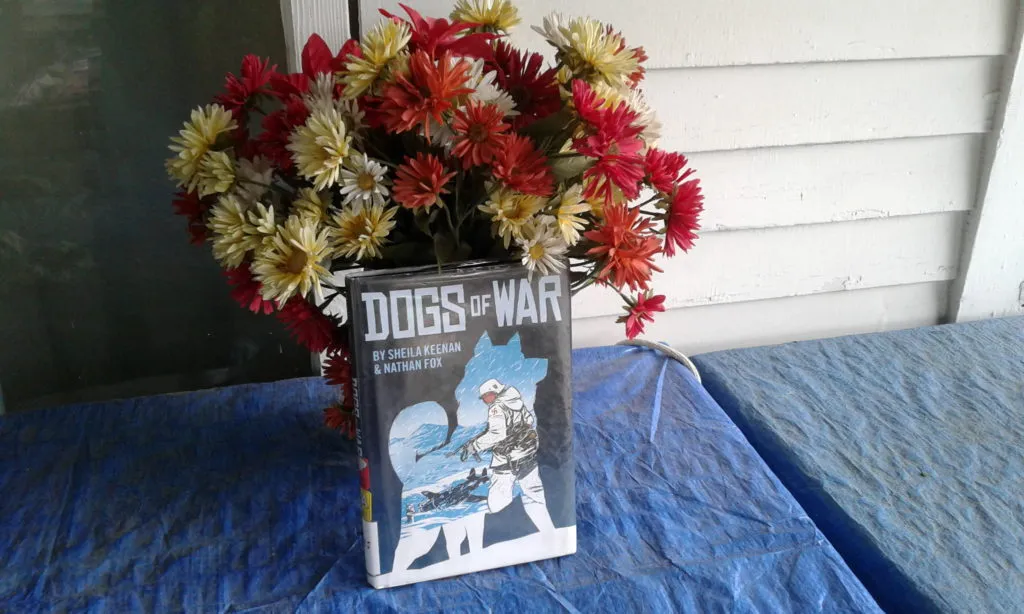Discovering a gem like Dogs of War often happens by chance. While donating a book at the library in memory of a coworker, I wandered into the young adult section and spotted this graphic novel about military dogs. For dog lovers and history enthusiasts, it’s a captivating read that explores the unbreakable bonds between soldiers and their canine companions during major wars. Without resorting to graphic violence, author Sheila Keenan and illustrator Nathan Fox deliver powerful stories of loyalty, bravery, and sacrifice—”Dogs Of War Graphic Novel” perfectly captures these timeless themes.
 Dogs of War graphic novel cover showing heroic military dogs in action
Dogs of War graphic novel cover showing heroic military dogs in action
The Remarkable Stories of Boots, Loki, and Sheba
The book weaves three fictionalized accounts inspired by real events across World War I, World War II, and the Vietnam War, highlighting dogs’ vital roles on the battlefield.
In the first tale, “Boots,” set on the Western Front during WWI, follows a mercy dog trained by the Red Cross. These courageous canines, often Airedales or other sturdy breeds, navigated no-man’s-land amid shell craters and barbed wire to locate wounded soldiers left for dead. Boots searches tirelessly, carrying medical supplies and alerting medics, embodying the mercy dogs’ heroic legacy. Historical records confirm over 16,000 dogs served in WWI, saving countless lives through such rescue efforts, as noted by organizations like the American Kennel Club (AKC).
Shifting to WWII, “Loki” features a sled dog at a remote U.S. airbase in Greenland (Bluie West One). Amid Arctic blizzards, Loki pulls sleds loaded with supplies, aiding planes en route to Europe. The story builds suspense during a whiteout rescue of a downed American plane, where Loki races against German forces. Sled dogs like huskies proved invaluable in harsh terrains, preventing enemy incursions and supporting logistics—much like modern working dogs in extreme conditions.
The Vietnam segment, “Sheba,” showcases a scout dog’s prowess. Sheba, paired with handler Lanford, detects snipers, booby traps, and trip wires in dense jungles. These German Shepherds and Labrador mixes saved thousands of lives; statistics from the U.S. War Dog Association reveal over 4,000 dogs served in Vietnam, though many didn’t return home due to policies treating them as equipment. Sheba’s story underscores the emotional toll on handlers, mirroring personal accounts from veterans.
For pet owners, these narratives highlight the importance of training and bonding. War dogs underwent rigorous preparation, fostering discipline and trust—skills transferable to everyday canine companions. If you’re raising a puppy with potential for service or just loyalty, explore resources like the best dog training books for puppies.
Dynamic Illustrations and Accessible Storytelling
Nathan Fox’s black-and-white artwork is a standout, with intricate, cinematic panels that evoke chaos and camaraderie. Though sometimes overwhelmingly detailed—blending figures and landscapes—the style immerses readers in the fog of war, trenches, and jungles. Keenan’s text complements this, using straightforward language suitable for ages 10-14, yet engaging for adults. Dialogue feels authentic, drawing from veterans’ testimonies.
The afterword expands on military working dogs’ history, from WWI messengers to modern K-9 units. It addresses tough realities, like Vietnam dogs left behind, tempered for young readers while sparking discussions on animal welfare.
This format makes complex history digestible, outperforming traditional texts by visualizing emotions and action. Dog enthusiasts will appreciate breed insights—mercy dogs’ stamina, sled dogs’ endurance, scouts’ scent prowess—offering lessons for selecting and training family pets.
Why Dogs of War Stands Out for Dog Lovers and History Buffs
At around 200 pages, Dogs of War blends education with entertainment, earning praise from Kirkus Reviews for its thrilling portrayals and School Library Journal for grades 5-up appeal. It’s ideal for reluctant readers or classrooms teaching WWII and beyond.
Pet parents can draw parallels: these dogs’ loyalty stems from consistent training and strong human-animal bonds, much like today’s programs. Structured routines build similar heroism in your furry friend—consider following Zak George’s puppy training 30 days for proven methods.
In summary, Dogs of War honors canine heroes without glorifying violence, reminding us of dogs’ profound impact. Whether you’re a dog owner fostering loyalty or seeking unique history reads, grab this graphic novel. Consult veteran memoirs or AKC resources for deeper dives, and share your favorite war dog stories in the comments!
References
- Keenan, Sheila. Dogs of War. Graphix/Scholastic, 2013.
- American Kennel Club. “Military Working Dogs.” AKC.org.
- U.S. War Dogs Association. Vietnam War Dog Statistics.
